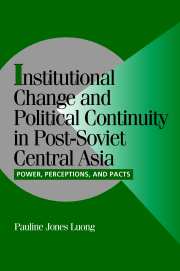 Institutional Change and Political Continuity in Post-Soviet Central Asia
Institutional Change and Political Continuity in Post-Soviet Central Asia Book contents
- Frontmatter
- Contents
- Tables and Figures
- Note on Transliteration
- Acronyms
- Acknowledgments
- 1 THE CONTINUITY OF CHANGE: OLD FORMULAS AND NEW INSTITUTIONS
- 2 EXPLAINING INSTITUTIONAL DESIGN IN TRANSITIONAL STATES: BEYOND STRUCTURE VERSUS AGENCY
- 3 SOURCES OF CONTINUITY: THE SOVIET LEGACY IN CENTRAL ASIA
- 4 SOURCES OF CHANGE: THE TRANSITIONAL CONTEXT IN CENTRAL ASIA
- 5 ESTABLISHING AN ELECTORAL SYSTEM IN KYRGYZSTAN: RISE OF THE REGIONS
- 6 ESTABLISHING AN ELECTORAL SYSTEM IN UZBEKISTAN: REVENGE OF THE CENTER
- 7 ESTABLISHING AN ELECTORAL SYSTEM IN KAZAKHSTAN: THE CENTER'S RISE AND THE REGIONS' REVENGE
- 8 INSTITUTIONAL CHANGE THROUGH CONTINUITY: SHIFTING POWER AND PROSPECTS FOR DEMOCRACY
- Appendix I Sample Interview Questions
- Appendix II Career Patterns of Regional Leaders in Soviet and Post-Soviet Central Asia
- References
- Index
4 - SOURCES OF CHANGE: THE TRANSITIONAL CONTEXT IN CENTRAL ASIA
Published online by Cambridge University Press: 02 September 2009
- Frontmatter
- Contents
- Tables and Figures
- Note on Transliteration
- Acronyms
- Acknowledgments
- 1 THE CONTINUITY OF CHANGE: OLD FORMULAS AND NEW INSTITUTIONS
- 2 EXPLAINING INSTITUTIONAL DESIGN IN TRANSITIONAL STATES: BEYOND STRUCTURE VERSUS AGENCY
- 3 SOURCES OF CONTINUITY: THE SOVIET LEGACY IN CENTRAL ASIA
- 4 SOURCES OF CHANGE: THE TRANSITIONAL CONTEXT IN CENTRAL ASIA
- 5 ESTABLISHING AN ELECTORAL SYSTEM IN KYRGYZSTAN: RISE OF THE REGIONS
- 6 ESTABLISHING AN ELECTORAL SYSTEM IN UZBEKISTAN: REVENGE OF THE CENTER
- 7 ESTABLISHING AN ELECTORAL SYSTEM IN KAZAKHSTAN: THE CENTER'S RISE AND THE REGIONS' REVENGE
- 8 INSTITUTIONAL CHANGE THROUGH CONTINUITY: SHIFTING POWER AND PROSPECTS FOR DEMOCRACY
- Appendix I Sample Interview Questions
- Appendix II Career Patterns of Regional Leaders in Soviet and Post-Soviet Central Asia
- References
- Index
Summary
The institutional design process in Kazakhstan, Kyrgyzstan, and Uzbekistan shared striking similarities in that their respective negotiations over establishing new electoral systems were characterized by the common prevalence of regionalism. Nonetheless, these negotiations produced a distinct outcome in each state. The previous chapter demonstrated that these three states shared a structural-historical context that fundamentally shaped their predominant sociopolitical cleavages. Yet, the fact that distinct institutional outcomes emerged from such similar negotiation processes indicates that, while the structural-historical context illuminates the sources of institutional continuity, it alone is insufficient to explain institutional origin and change. The purpose of this chapter is to identify the sources of change, which, I argue, are found in the particular features of the immediate-strategic setting actors confront in transitional states, or the transitional context.
The transitional context plays a crucial role in indicating to established and emergent actors alike the direction and degree to which the initial parameters set up by the structural-historical context have changed, are changing, and will continue to change. While the structural-historical context defines who the established actors are, their interests (from which specific preferences emerge), and their relative capacities, none of these elements are fixed or static during a time of transition. Rather, the very nature of transition provides great potential for each of these main components in the bargaining game to change because, as I argue in Chapter 2, it represents an exogenous shock to status quo asymmetrical power relations.
- Type
- Chapter
- Information
- Institutional Change and Political Continuity in Post-Soviet Central AsiaPower, Perceptions, and Pacts, pp. 102 - 155Publisher: Cambridge University PressPrint publication year: 2002


